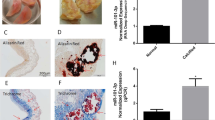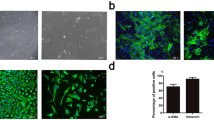Abstract
To discuss the effect and mechanism of circular-CCND1 (circ-CCND1) on the regulation of calcified aortic valve disease (CAVD). Differentially expressed circRNAs were screened through the GSE155119 data set and biological prediction. Subsequently, the miR-138-5p, CCND1, and circ-CCND1 expression were detected in the non-calcified and calcified aortic valve. Then Pearson correlation analysis was performed to analyze the correlation between the above expression, and dual luciferase and RNA-pull down assays for verifying the target relationship. Porcine aortic valve interstitial cells (AVICs) were isolated and transfected with pcDNA-circ-CCND1, miR-138-5p inhibitor, and miR-138-5p mimics. The alkaline phosphatase (ALP) activity was quantitatively analyzed by ALP staining, and alizarin-red staining was to check the calcium nodules formation. Finally, Western blot was applied to detect the expression of proteins associated with osteogenic differentiation (Runx2, Osterix, OPN) and CCND1/P53/P21 pathway proteins. Circ-CCND1 was highly expressed in calcific aortic valves. After inhibiting circ-CCND1 expression, a significant reduction was shown in ALP activity, the degree of ossification and the formation of calcium nodules in AVICs, and osteogenic differentiation-related protein expression and CCND1/P53/P21 pathway protein expression. By contrast, inhibition of miR-138-5p and circ-CCND1 together promoted the calcification of AVICs and expression of CCND1/P53/P21 pathway proteins. P53 inhibitor (PFT-α) could significantly reduce activation of CCND1/P53/P21 pathway protein expression by circ-CCND1 overexpression. However, P53 activator (Nutlin-3) significantly restored the suppression of the above pathway-related protein expression by downregulation of circ-CCND1. Circ-CCND1 sponges miR-138-5p to regulate CCND1 expression, thereby promoting the calcification of AVICs.






Similar content being viewed by others
Change history
19 July 2022
A Correction to this paper has been published: https://doi.org/10.1007/s13105-022-00911-7
References
Ashwal-Fluss R, Meyer M, Pamudurti NR et al (2014) circRNA biogenesis competes with pre-mRNA splicing. Mol Cell 56:55–66. https://doi.org/10.1016/j.molcel.2014.08.019
Chen J, Li Y, Zheng Q et al (2017) Circular RNA profile identifies circPVT1 as a proliferative factor and prognostic marker in gastric cancer. Cancer Lett 388:208–219. https://doi.org/10.1016/j.canlet.2016.12.006
Chen S, Li T, Zhao Q et al (2017) Using circular RNA hsa_circ_0000190 as a new biomarker in the diagnosis of gastric cancer. Clin Chim Acta 466:167–171. https://doi.org/10.1016/j.cca.2017.01.025
Dweck MR, Boon NA, Newby DE (2012) Calcific aortic stenosis: a disease of the valve and the myocardium. J Am Coll Cardiol 60:1854–1863. https://doi.org/10.1016/j.jacc.2012.02.093
Gao L, Ji Y, Lu Y et al (2018) Low-level overexpression of p53 promotes warfarin-induced calcification of porcine aortic valve interstitial cells by activating Slug gene transcription. J Biol Chem 293:3780–3792. https://doi.org/10.1074/jbc.M117.791145
Hansen TB, Kjems J, Damgaard CK (2013) Circular RNA and miR-7 in cancer. Cancer Res 73:5609–5612. https://doi.org/10.1158/0008-5472.Can-13-1568
Jana S, Lerman A (2019) Behavior of valvular interstitial cells on trilayered nanofibrous substrate mimicking morphologies of heart valve leaflet. Acta Biomater 85:142–156. https://doi.org/10.1016/j.actbio.2018.12.005
Jiao W, Zhang D, Wang D et al (2019) MicroRNA-638 inhibits human aortic valve interstitial cell calcification by targeting Sp7. J Cell Mol Med 23:5292–5302. https://doi.org/10.1111/jcmm.14405
Kim CW, Go RE, Ko EB et al (2020) Effects of cigarette smoke components on myocardial differentiation of mouse embryonic stem cells. Environ Toxicol 35:66–77. https://doi.org/10.1002/tox.22843
Kristensen LS, Andersen MS, Stagsted LVW et al (2019) The biogenesis, biology and characterization of circular RNAs. Nat Rev Genet 20:675–691. https://doi.org/10.1038/s41576-019-0158-7
Li B, Li Y, Hu L et al (2020) Role of circular rnas in the pathogenesis of cardiovascular disease. J Cardiovasc Transl Res 13:572–583. https://doi.org/10.1007/s12265-019-09912-2
Orosz E, Kiss I, Gyöngyi Z et al (2018) Expression of circulating miR-155, miR-21, miR-221, miR-30a, miR-34a and miR-29a: comparison of colonic and rectal cancer. In Vivo 32:1333–37. https://doi.org/10.21873/invivo.11383
Peeters F, Meex SJR, Dweck MR et al (2018) Calcific aortic valve stenosis: hard disease in the heart: a biomolecular approach towards diagnosis and treatment. Eur Heart J 39:2618–2624. https://doi.org/10.1093/eurheartj/ehx653
Qin M, Liu G, Huo X et al (2016) Hsa_circ_0001649: a circular RNA and potential novel biomarker for hepatocellular carcinoma. Cancer Biomark 16:161–169. https://doi.org/10.3233/cbm-150552
Rajamannan NM, Moura L (2016) The lipid hypothesis in calcific aortic valve disease: the role of the multi-ethnic study of atherosclerosis. Arterioscler Thromb Vasc Biol 36:774–776. https://doi.org/10.1161/atvbaha.116.307435
Ritchie ME, Phipson B, Wu D et al (2015) Limma powers differential expression analyses for RNA-sequencing and microarray studies. Nucleic Acids Res 43:e47. https://doi.org/10.1093/nar/gkv007
Saikrishnan N, Kumar G, Sawaya FJ et al (2014) Accurate assessment of aortic stenosis: a review of diagnostic modalities and hemodynamics. Circulation 129:244–253. https://doi.org/10.1161/circulationaha.113.002310
Wang X, Lee J, Ali M et al (2017) Phenotype transformation of aortic valve interstitial cells due to applied shear stresses within a microfluidic chip. Ann Biomed Eng 45:2269–2280. https://doi.org/10.1007/s10439-017-1871-z
Wang Y, Han D, Zhou T et al (2020) Melatonin ameliorates aortic valve calcification via the regulation of circular RNA CircRIC3/miR-204-5p/DPP4 signaling in valvular interstitial cells. J Pineal Res 69:e12666. https://doi.org/10.1111/jpi.12666
Yu C, Wu D, Zhao C et al (2021) CircRNA TGFBR2/MiR-25-3p/TWIST1 axis regulates osteoblast differentiation of human aortic valve interstitial cells. J Bone Miner Metab 39:360–371. https://doi.org/10.1007/s00774-020-01164-4
Yutzey KE, Demer LL, Body SC et al (2014) Calcific aortic valve disease: a consensus summary from the alliance of investigators on calcific aortic valve disease. Arterioscler Thromb Vasc Biol 34:2387–2393. https://doi.org/10.1161/atvbaha.114.302523
Zang Y, Li J, Wan B et al (2020) circRNA circ-CCND1 promotes the proliferation of laryngeal squamous cell carcinoma through elevating CCND1 expression via interacting with HuR and miR-646. J Cell Mol Med 24:2423–2433. https://doi.org/10.1111/jcmm.14925
Zheng D, Zang Y, Xu H et al (2019) MicroRNA-214 promotes the calcification of human aortic valve interstitial cells through the acceleration of inflammatory reactions with activated MyD88/NF-κB signaling. Clin Res Cardiol 108:691–702. https://doi.org/10.1007/s00392-018-1398-9
Author information
Authors and Affiliations
Contributions
YF contributed to conception and design of the study. XX, QH and WZ performed the statistical analysis. YF wrote the first draft of the manuscript. XX, QH, WZ, TW, DD, and LS wrote sections of the manuscript. All authors contributed to manuscript revision, read, and approved the submitted version. The authors declare that all data were generated in-house and that no paper mill was used.
Corresponding author
Ethics declarations
Ethics approval
This study was approved by the Medical Ethics Committee of The First Affiliated Hospital of Xinjiang Medical University (K202107-09).
Conflict of interest
The authors declare no competing interests.
Additional information
Publisher's Note
Springer Nature remains neutral with regard to jurisdictional claims in published maps and institutional affiliations.
Key points
1)Circ-CCND1 regulates the expression of CCND1 through sponging miR-138-5p and therefore promotes the calcification of AVIC cells.
2)Circ-CCND1 is highly expressed in calcified aortic valve leaflets.
3)Circ-CCND1 can be used as a diagnostic marker for CAVD.
Rights and permissions
About this article
Cite this article
Yan, F., Xie, X., Huo, Q. et al. circ-CCND1 regulates the CCND1/P53/P21 pathway through sponging miR-138-5p in valve interstitial cells to aggravate aortic valve calcification. J Physiol Biochem 78, 845–854 (2022). https://doi.org/10.1007/s13105-022-00907-3
Received:
Accepted:
Published:
Issue Date:
DOI: https://doi.org/10.1007/s13105-022-00907-3




